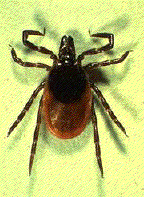 |
Rocky
Mountain Spotted Fever and Lyme Disease Surveillance Program in Indiana: Final Report, 1998 Robert R. Pinger, Ph.D. Department of Physiology and Health Science Ball State University |
 |
Appendix B
 |
Rocky
Mountain Spotted Fever and Lyme Disease Surveillance Program in Indiana: Final Report, 1998 Robert R. Pinger, Ph.D. Department of Physiology and Health Science Ball State University |
 |
A total of 789 ticks were submitted for testing between January 1 and December 31, 1998. This total is more than the 547 ticks submitted last year but less than the 841 ticks submitted in 1996. More specimens of all major species were received in 1998 than in 1997.
Species Composition
Eight species of ticks were received in 1998 (Table 1). This year, for the first time, the blacklegged tick, Ixodes scapularis was the predominant species, making up nearly 48% of all ticks sent to the lab. Three hundred twelve of these (83%) were collected in Newton County. The American dog tick, Dermacentor variabilis, was the second most abundant species constituting 34% of all the ticks received. The lone star tick, Amblyomma americanum, made up just over 14% of the total. Together, these three species made up almost 97% of all the ticks received (Figure 1). The other species collected in 1998 (and the number of specimens received) were the winter tick, Dermacentor albipictus (13), the woodchuck tick, Ixodes cookei (4), the brown dog tick, Rhipicephalus sanguineus (7), the gulf coast tick, Amblyomma maculatum (1) and the eastern rabbit tick, Ixodes dentatus (1). There were four specimens that could not be identified because they were damaged.
Geographic Distribution
Ticks were submitted from 71 of Indiana's 92 counties, eleven more counties than in 1997. Eighteen ticks were submitted from six other states: Illinois (1), Kentucky (1), Michigan (1), Minnesota (1), Missouri (9); and Tennessee (5). The Indiana counties submitting the greatest number of ticks (and the number submitted from each) were: Newton (313), Franklin (48), Lawrence (40), Bartholomew (32), Jasper (21) Pulaski (21) and Vanderburgh (20). The distribution by county of ticks submitted in 1998 is shown in Figure 2.
Table 1.
Species Composition of Ticks Submitted for Testing in Indiana in 1998
Species |
Number |
% |
Ixodes scapularis |
377 |
48 |
Dermacentor variabilis |
268 |
34 |
Amblyomma americanum |
114 |
14.4 |
Dermacentor albipictus |
13 |
1.5 |
Rhipicephalus sanguineus |
7 |
0.9 |
Ixodes cookei |
4 |
0.5 |
Amblyomma maculatum |
1 |
0.1 |
Ixodes dentatus |
1 |
0.1 |
Unidentified ticks/non-ticks |
4 |
0.5 |
TOTAL |
789 |
100 |
Figure 1.
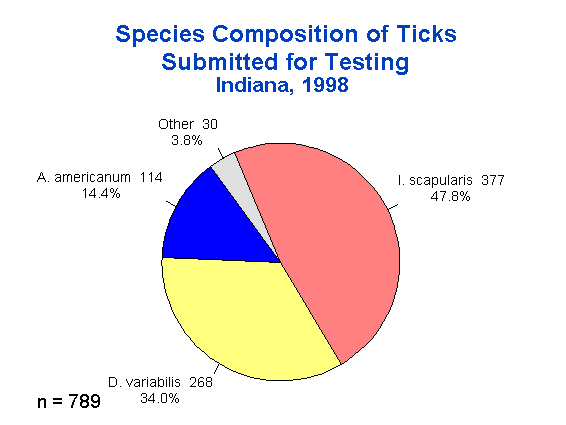
Figure 2. Distribution by County of Ticks Submitted in 1998
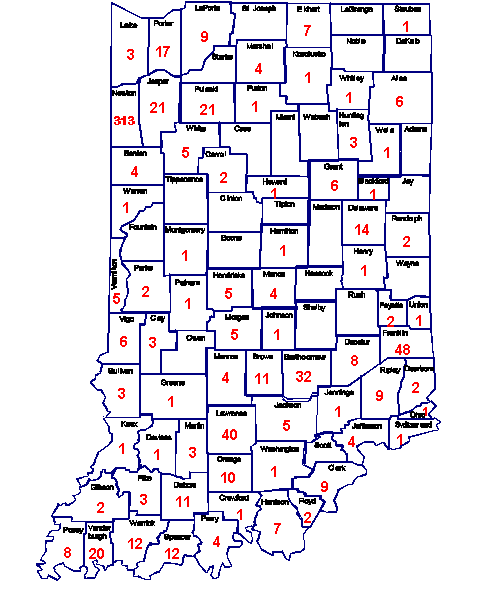
Seasonal Distribution
The seasonal distribution for all ticks by the date of collection is presented in Table 2. There were two peaks in submissions, one in May representing D. variabilis adults, A. americanum adults and nymphs, and one in October-November representing primarily I. scapularis adults.
Table 2.
Monthly Distribution of Ticks Submitted for Testing
Indiana 1998
Month |
Number Received |
January |
2 |
February |
7 |
March |
1 |
April |
93 |
May |
131 |
June |
83 |
July |
57 |
August |
24 |
September |
22 |
October |
122 |
November |
221 |
December |
26 |
TOTAL |
789 |
The seasonal distribution of ticks is more meaningful when viewed by species. Figures 3-6 depict the seasonal distributions of three species of public health importance (D. variabilis, A. americanum, and I. scapularis) based upon our records of submissions. As usual, D. variabilis populations were high during April through July, with the peak of adult activity in May (Figure 3).
Figure 3.
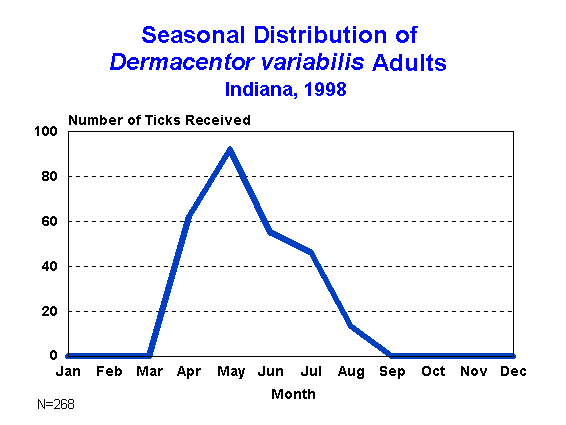
Because of differences in the seasonal activity of adults and nymphs of A. americanum, these are displayed in two separate graphs (Figure 4 & 5). In 1998, we received more A. americanum adults in April than any other month (Figure 4). Amblyomma americanum nymphs peaked a month later, in May. There was a characteristic second, smaller peak in August (Figure 5).
Figure 4.
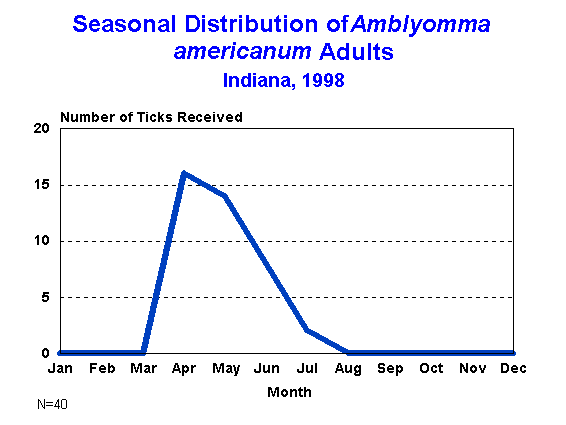
Figure 5.

The peak for I. scapularis occurred in November when we received 212 ticks, followed by October (120), December (25) and September (8) (Figure 6). About 83% (313/377) of the I. scapularis ticks were sent to the Lab by Dave Spitznagle at the Willow Slough Fish and Wildlife Area in Newton County.
Figure 6.
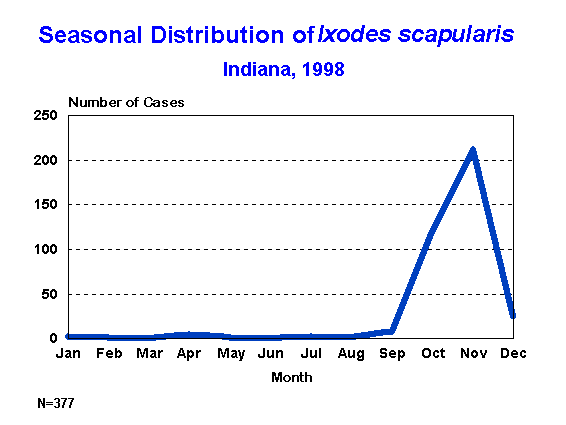
Hosts
In Figures 7-9, host data are presented for A. americanum, D. variabilis, and I. scapularis. Approximately 95% of D. variabilis (Figure 7) and 99% of A. americanum (Figure 8) were collected from humans.
Figure 7.
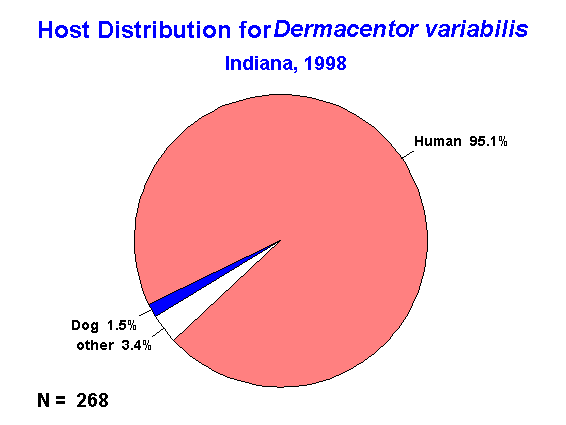
Figure 8.
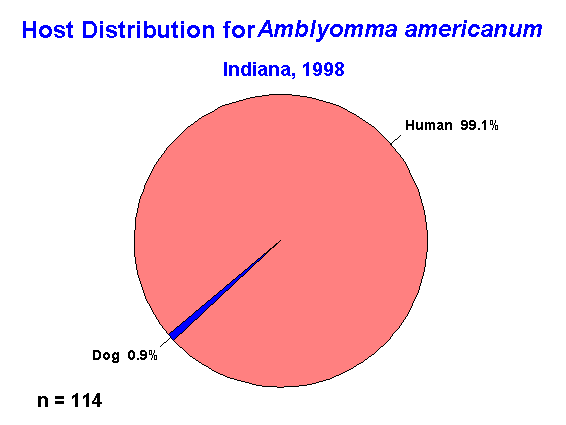
Forty-six percent (174/377) of I. scapularis were collected from deer, 48% (181/377) from dogs, and 4% (16/377) from humans (Figure 9).
Figure 9.
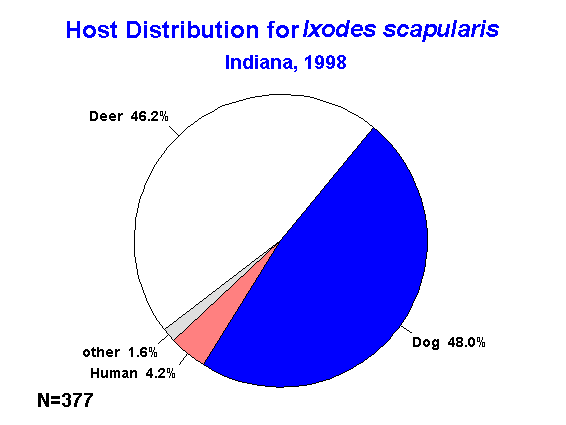
Testing
A total of 209 D. variabilis and 52 A. americanum were tested for spotted fever group (SFG) rickettsiae. Of these, eleven D. variabilis and zero A. americanum ticks were positive by the Gimenez screening test. None of the D. variabilis positive by Gimenez was positive by immunofluorescence (FITC). Fourteen I. scapularis ticks were tested for B. burgdorferi by fluorescent antibody test; all were negative.
Human Cases of Tick-borne Diseases in Indiana, 1970-1998
Confirmed human cases of known tick-borne diseases in Indiana for 1970-1998 are presented in Table 3. For 1998, 2 cases of RMSF, 24 cases of Lyme disease (LD), and 1 case of human monocytic ehrlichiosis (HME) have been confirmed. The asterisks (*) indicate that the 1998 figures are provisional.
Table 3.
Confirmed Cases of Three Tick-Borne Diseases,
Indiana, 1970-1998
Year |
RMSF |
LD |
Ehrlichiosis |
1970 |
6 |
- |
- |
1971 |
9 |
- |
- |
1972 |
13 |
- |
- |
1973 |
6 |
- |
- |
1974 |
7 |
- |
- |
1975 |
5 |
- |
- |
1976 |
8 |
- |
- |
1977 |
15 |
- |
- |
1978 |
6 |
- |
- |
1979 |
7 |
- |
- |
1980 |
7 |
- |
- |
1981 |
6 |
- |
- |
1982 |
16 |
- |
- |
1983 |
16 |
2 |
- |
1984 |
7 |
0 |
- |
1985 |
4 |
1 |
- |
1986 |
0 |
0 |
- |
1987 |
3 |
4 |
- |
1988 |
4 |
3 |
- |
1989 |
1 |
4 |
- |
1990 |
7 |
15 |
- |
1991 |
13 |
17 |
- |
1992 |
2 |
19 |
- |
1993 |
3 |
32 |
- |
1994 |
8 |
19 |
5 |
1995 |
8 |
16 |
3 |
1996 |
7 |
15 |
7 |
1997 |
1 |
16 |
2 |
1998 |
2* |
24* |
1* |
Rocky Mountain Spotted Fever (RMSF)
In the past 29 years, there have been approximately 210 confirmed cases of RMSF in
Indiana. The geographic distribution of these confirmed cases by county of residence for
the period 1970-1998 is illustrated in Figure 10. A significant number of cases have been
confirmed in residents of counties located along the Ohio River, the northern tier of
counties, and the more densely populated, Marion County. Vanderburgh County has reported
44 cases in the past 28 years, far more than any other Indiana County, perhaps in part
because it is recognized as a regional medical center for surrounding counties.
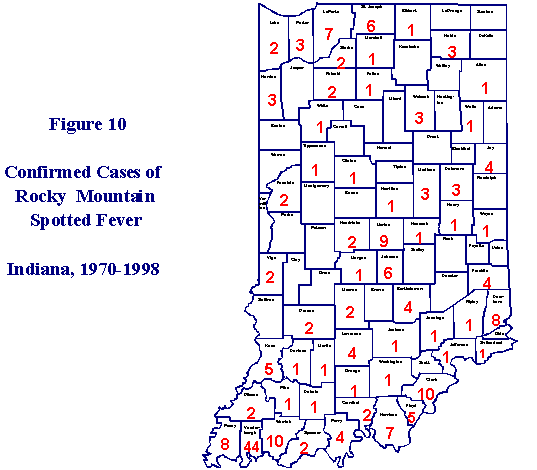
Lyme Disease
Lyme disease was first reported in Indiana in 1983 (Table 3). Since then, nearly 200
cases have been confirmed in Indiana residents. Figure 11 shows the distribution of 20 of
the 24 confirmed cases of Lyme disease for 1998. Thirteen additional clinical cases
of LD have been reported, some of which may eventually be confirmed. Thus, the final count
for 1998 could exceed 30.
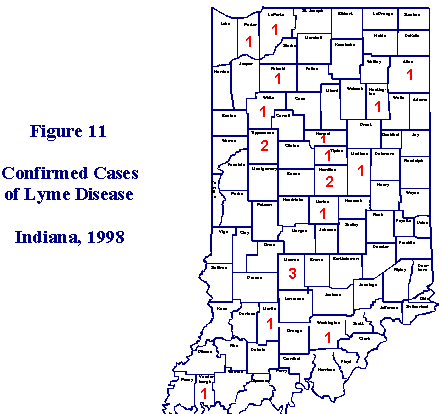
Human Monocytic Ehrlichiosis
Since 1994, when the first cases of human ehrlichiosis in Indiana were reported to the Indiana State Department of Health, a total of 18 cases have been confirmed from eleven Indiana counties. Figure 12 shows the distribution of these 18 confirmed HME cases. In 1998, cases were reported from Dubois, Perry and Warrick Counnties. Studies in our laboratory have established the presence of the causative agent of this disease, Ehrlichia chaffeensis in ticks collected in southern Indiana. Using PCR analysis, have found that the average, minimum field infection rate of A. americanum adults in southern counties of Indiana is about 4.5 %. Infected ticks were discovered in Crawford, Spencer and Warrick Counties (Burket et al., J.Med.Entomol. 35(5): 653-659).
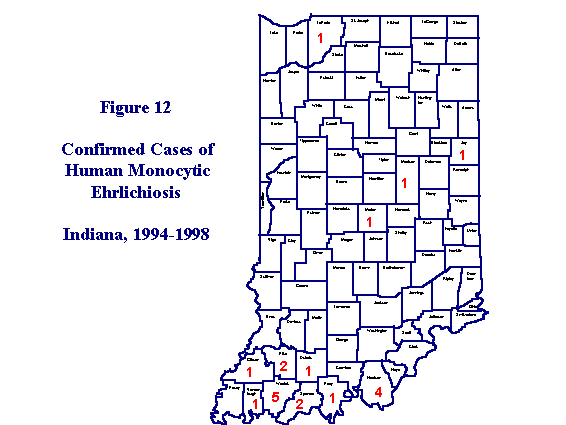
Lyme Disease Tick Surveillance in 1998
Hunter-killed deer were examined for ticks by more than 28
volunteers staffing 19 deer checking stations in 17 counties. The results of this survey
are available in a separate report, Survey of Indiana Deer for Ixodes scapularis
Ticks: 1998 Final Report.
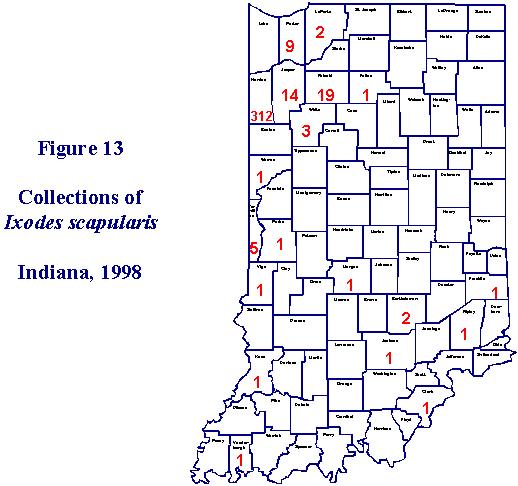
In summary, 226 ticks were recovered from 52 of 1,167 deer (4.5%) examined in 1998. The percentage of positive deer, 4.5% was higher than the 1.8% of 1652 deer examined in 1997, the 1.6% of 1,049 deer examined in 1996, and the 1.5% of the 819 deer examined in 1995. The vast majority of these ticks was sent to us by Dave Spitznagle from Willow Slough Fish and Wildlife Area.
During the 1998 deer survey, ticks were collected for the first time from deer killed in the following four counties: Bartholomew, Johnson, Parke, and Ripley bringing the number of counties in which infested deer have been found since 1990 to 26. Ixodes scapularis ticks were also submitted from Clark and Warren Counties in 1998 bringing the total number new county records in 1998 to five, and the number of Indiana counties with at least one I. scapularis to 42.
Conclusions
The number of ticks received in 1998, 789, was greater than that received in 1997, 547. The proportion of ticks identified as I. scapularis increased from 38% to 48%, while the percentage of D. variabilis declined slightly, from 39% to 34%. Amblyomma americanum made up 14% of the total.
The seasonal distributions of the species of primary interest in this report were similar to those of previous years. Ixodes scapularis peaked later in 1998 than in 1997, perhaps because of the mild Fall. There were five new county records for I. scapularis, bringing the total number of counties from which at least one specimen has been reported to 42.
The percentage of ticks that test positive for SFG rickettsiae remains small. None of the ticks examined in 1997 or 1998 were positive for SFG rickettsiae.
The distribution of the American dog tick, the primary vector of RMSF in Indiana, seems to remain constant. But the distributions of the lone star tick and the blacklegged tick do seem to be expanding in response to the availability of suitable hosts, primarily deer. This could eventually be reflected in an increase in cases of Lyme disease and HME in Indiana.
There remains a great deal of public concern about tick-borne diseases in Indiana. However, the number of confirmed cases of these diseases remains fairly low. There is always the question of proper diagnoses and accurate reporting of these diseases.
We are currently testing I. scapularis ticks from northern Indiana for evidence of infection with the agent that causes human granulocytic ehrlichiosis (HGE). So far, we have found no evidence that Indiana ticks are infected with this agent.
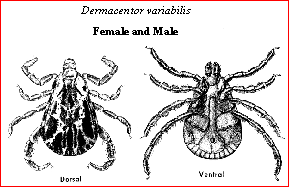
Acknowledgments
This program was sponsored by the Indiana State Department of Health and Ball State University. I thank Dr. Michael J. Sinsko for his support and encouragement, and my student, Ryan Irving for his help with this research. Thanks also go to Fresia Steiner for sharing her expertise in molecular biology. Thanks also to Cheryl Thomas of the Indiana State Department of Health who helped me format this report and to Connie McOmber, cartographer, Department of Geography, Ball State University, for her help with the maps. I also thank Laura Philips and Brian Means of Ball State University's Computer Services for their help setting up and maintaining the new Tick Database.
I also thank Dr. James Pyle and Kathryn Pertler of Ball State's Office of Academic Research and Sponsored Programs for their assistance with the Budget and Lola Miller of Ball State’s Contracts and Grants Office for her help with the project budget. Lastly, I thank Dr. Dale Hahn, chairman of the Department of Physiology and Health Science, Don VanMeter, Associate Dean of the college of Sciences and Humanities for their support of this project.
[an error occurred while processing this directive]